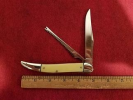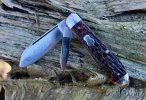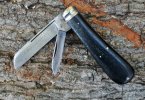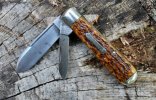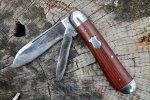-
The BladeForums.com 2024 Traditional Knife is available! Price is $250 ea (shipped within CONUS).
Order here: https://www.bladeforums.com/help/2024-traditional/
You are using an out of date browser. It may not display this or other websites correctly.
You should upgrade or use an alternative browser.
You should upgrade or use an alternative browser.
The defining US pocket knife
- Thread starter Rsmith_77
- Start date
- Joined
- Mar 10, 2011
- Messages
- 7,893
meako
Gold Member
- Joined
- Sep 4, 2006
- Messages
- 10,071
Just say the first thing that comes to your mind...Buck 110.
But then.....Where do Americans come from ?
History is the house that all other subjects dwell in....I like the story American Gods...by Neil Gaiman.....so eg The Australian Bunny knife...marketing. ...it was already there...they found a fairly good reason to sell heaps more.....hang on a minute..scary diver helmet guy with glowing eyes...uuuhhrrrrrrrr..
yioikss ...ront ret ris gret proritical raggy...
But then.....Where do Americans come from ?
History is the house that all other subjects dwell in....I like the story American Gods...by Neil Gaiman.....so eg The Australian Bunny knife...marketing. ...it was already there...they found a fairly good reason to sell heaps more.....hang on a minute..scary diver helmet guy with glowing eyes...uuuhhrrrrrrrr..
yioikss ...ront ret ris gret proritical raggy...
Will Power
Gold Member
- Joined
- Jan 18, 2007
- Messages
- 33,569
In some ways, William (Bill) Scagel 1873-1963 should be mentioned as having a profound influence on American knife making and even pocket-knives. Can't say if he was the first to put a hole in his blades as an opener rather than a nick but his knives clearly influenced design in a particular American way. Problem is, you need to be a millionaire to afford one of the originals (not the interesting 'repros' that came later) .
afishhunter
Basic Member
- Joined
- Oct 21, 2014
- Messages
- 14,762
in 1964 Buck changed the face of cutlery over night. The "Buck knife" became THE knife to have. Construction workers, truck drivers, warehouse men, hunters, campers, military personnel, and even bikers, had the black pouch on the belt. When I served in the army, the PX had the Buck 110 for a price much lower than the civilian stores, and everyone, from the chairborne rangers in the headquarters to the cooks assistant had the black pouch. In Vietnam the Buck 110 was everywhere, as well as the Buck 119.
The 110 could be a contender ... however ... is it really a "pocket knife"? To me, (YMMV) just the sheer size (5" closed), and/or call it "1/2 pound" weight, (standard version) regulate it to "belt knife" status.Ya know
I didn't consider the buck 110
Not even the first "American" car. Henry started selling cars in 1900 or 1901. Ransom E. Olds was selling his Curved Dash Olds(mobile) in 1895.Ford also wasn't the first car
Last edited:
- Joined
- Jul 21, 2018
- Messages
- 2,149
Even old world knives received influences from other parts of continent as well as elsewhere so tough to say a specific knife is completely home spun. For the US of A the stockman is a good choice and I think the Americanized Barlow has merit too but I think the big, brass bolstered lockback is the “defining” American knife as so many foreign and domestic manufacturers copied the Buck 110 in the second half of 20th Century and as stated elsewhere in this thread led to the modern locking folder. Its big, its brash, its tough and its a general workhorse that found its way onto belts and into pockets of servicemen, outdoorsmen, Boy Scouts, lawmen, and bikers too. Two great examples: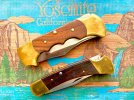

- Joined
- Nov 28, 2012
- Messages
- 8,808
I have a Buck 110. I have always considered it to be a belt knife. I would not carry something that heavy in my pocket, though I did carry a Buck 110 on my belt for years at work in a prior profession.The 110 could be a contender ... however ... is it really a "pocket knife"? To me, (YMMV) just the sheer size (5" closed), and/or call it "1/2 pound" weight, (standard version) regulate it to "belt knife" status.
I don't think there is such a thing as a definitive US pocket knife.
I don't think there is such a thing as a definitive US pocket knife.
I think you're right!
America has been such a melting pot for so many generations now, with such varying cultures and other conditions, that its a true hash. And it varies so much just from one generation to the next. My taste in knives was different than my dads, and my kids is different from me. The world moves faster than we think. When I was a kid, I used to stare at the knife display at the hardware store, with stockmen, trappers, tear drop pens, Barlows, muskrats, scouts, lobsters, and more. But in all truth, I can't recall the last time I saw any of them being carried.
Now, all you see is the tell tale pocket clips of some one blade tactical that can be thumbed open in a blink of an eye. Go in a store that has knives and all you see these days is variations of a theme. That theme is largish single blade knives with liner locks and one hand opening, and they all look alike. Most are black, with some variations of color coating. There is almost no traditional knives on display, other than a few of the new China made Old Timers for the grandpa's among the customers.
If anything, I think that each generation has their own memories of the pocket knife of 'their' era.
- Joined
- Jul 21, 2018
- Messages
- 2,149
I always tend(ed) to carry 110s on belt but its really in same general size category as jumbo trappers which most folks consider a “pocket knife.”I have a Buck 110. I have always considered it to be a belt knife. I would not carry something that heavy in my pocket, though I did carry a Buck 110 on my belt for years at work in a prior profession.
I don't think there is such a thing as a definitive US pocket knife.
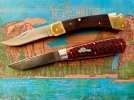
The 110 could be a contender ... however ... is it really a "pocket knife"? To me, (YMMV) just the sheer size (5" closed), and/or call it "1/2 pound" weight, (standard version) regulate it to "belt knife" status.
Not even the first "American" car. Henry started selling cars in 1900 or 1901. Ransom E. Olds was selling his Curved Dash Olds(mobile) in 1895.
Didn't know that.
The 110 could be a contender ... however ... is it really a "pocket knife"? To me, (YMMV) just the sheer size (5" closed), and/or call it "1/2 pound" weight, (standard version) regulate it to "belt knife" status.
This is what kept me from being a fan of the knife. I carried one for a short time, a very short time, before I asked myself what the heck I was dong? It was as heavy and many fixed blades, was still a folder, and was, like most knives, a one trick pony. A cutting tool only. It just seemed silly to me to have one thin blade supported by a huge amount of brass. I sold mine off to an incoming trope and just went back to carrying the Camillus demo knife. I never really understood the popularity of the Buck 110.
dantzk8
Basic Member
- Joined
- Nov 1, 2005
- Messages
- 1,951
This is what kept me from being a fan of the knife. I carried one for a short time, a very short time, before I asked myself what the heck I was dong? It was as heavy and many fixed blades, was still a folder, and was, like most knives, a one trick pony. A cutting tool only. It just seemed silly to me to have one thin blade supported by a huge amount of brass. I sold mine off to an incoming trope and just went back to carrying the Camillus demo knife. I never really understood the popularity of the Buck 110.
Exactly how I felt the first time I've handled a 110. It was a problem, I thought I was the only one who didn't like it.
Thanks for this post, i feel better now.
Dan.
Amir Fleschwund
Gold Member
- Joined
- Nov 29, 2008
- Messages
- 8,282
I think I recall
 Jack Black
explaing the English origins of the Barlow.
Jack Black
explaing the English origins of the Barlow.
And the Stockman came after the Cattle Knife.
The plain old Jack Knife, in many forms must go way back.
And can’t forget the Bowie.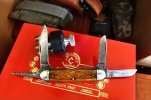
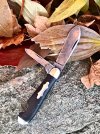

And the Stockman came after the Cattle Knife.
The plain old Jack Knife, in many forms must go way back.
And can’t forget the Bowie.



5K Qs
Gold Member
- Joined
- Jul 20, 2014
- Messages
- 15,792
Henry, if you re-read the post you quoted, you'll see that it referred to "plain Jane Russell", who I suspect is not the Jane Russell whose Barlow was revving your engine.I am going to say stockman. But if I could see one of those Jane Russell barlows, I might be persuaded to change my mind. Va-va-voom!
That Case yellow penknife is an incredibly useful and pleasant knife, and I think that you're correct that a huge number of pen knives have been owned by Americans, but I doubt if it would qualify as a uniquely American knife.When I was growing up ('60s & '70s), all the male teens and adults in my family and their friends had some version of a pen knife (or similar) in the pocket every day. Some of the women had a small pen knife in their clutches/ purses as well. Anything that couldn't be handled by the pen was handled by an appropriate cutting tool, primarily the fixed-blade that was always on their belt except when they were in their going-to-town/ school/ church/ wedding/ funeral clothes. The pen might not be the definitive US pocket knife, but where I roamed as a kid it was certainly the most ubiquitous. Others from other areas might have noticed differently. Late '70s/ early '80s I began to notice more people carrying the Buck 110, but it was a belt knife and not a pocket knife.
...

Basic 2-blade jacks of various patterns are probably what I saw the most growing up in the 1950s and 1960s. But I don't know if my experience generalizes to the entire nation across its entire history, nor do I know whether 2-blade jacks originated in, say, England and aren't uniquely American knives (I don't know exactly what "defining US pocket knife" means, and may be wrong in thinking it's equivalent to "uniquely American" or "originated in US").Plain old 2 blade jack knife, been around for a very long time in various handle and blade configurations, pretty much made by every manufacturer.
View attachment 2027638View attachment 2027639View attachment 2027640View attachment 2027642
But in 1964 Buck changed the face of cutlery over night. The "Buck knife" became THE knife to have. Construction workers, truck drivers, warehouse men, hunters, campers, military personnel, and even bikers, had the black pouch on the belt. When I served in the army, the PX had the Buck 110 for a price much lower than the civilian stores, and everyone, from the chairborne rangers in the headquarters to the cooks assistant had the black pouch. In Vietnam the Buck 110 was everywhere, as well as the Buck 119.
I can certainly agree that the Buck 110 is an iconic and influential knife, and is probably a good answer to the original question, except for the pocket knife part. But FWIW, I agree with those who are not fans of the Buck 110 because of its weight, and I also think it's a really ugly knife - I especially don't like that clip point blade shape.This is what kept me from being a fan of the knife. I carried one for a short time, a very short time, before I asked myself what the heck I was dong? It was as heavy and many fixed blades, was still a folder, and was, like most knives, a one trick pony. A cutting tool only. It just seemed silly to me to have one thin blade supported by a huge amount of brass. I sold mine off to an incoming trope and just went back to carrying the Camillus demo knife. I never really understood the popularity of the Buck 110.
- GT
Amir Fleschwund
Gold Member
- Joined
- Nov 29, 2008
- Messages
- 8,282
Jim, this is great!
- Joined
- Sep 15, 1999
- Messages
- 2,112
Abraham Lincoln carried a Congress....so that's another nod in it's favor.
For the sake of fun argument, I'll add the Remington Bullet knife in the mix.
View attachment 2031447
For the sake of fun argument, I'll add the Remington Bullet knife in the mix.
View attachment 2031447
Boattale
Gold Member
- Joined
- Nov 27, 2019
- Messages
- 2,577

